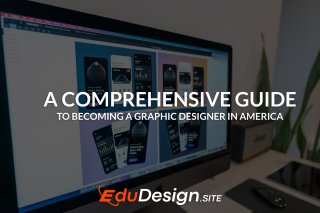
Welcome to Express Logos Your favorite marketplace for graphic design resources

© Copyright 2020. All Rights Reserved.
Privacy Policy
Terms & Conditions
Copyright Information
Article Special
A Comprehensive Guide to Becoming a Graphic Designer in America
A Comprehensive Guide to Becoming a Graphic Designer in America

Introduction :
Graphic design is a dynamic and creative field that offers numerous opportunities for individuals with a passion for art, design, and visual communication. If you are an American interested in pursuing a career in graphic design, this article will guide you through the steps to become a successful graphic designer.
Step 1: Develop Your Skills
Gain a solid foundation : Start by developing your artistic skills through drawing, painting, and studying art theory. This will help you understand the principles of design, color theory, and composition.
Acquire technical skills : Familiarize yourself with industry-standard graphic design software such as Adobe Creative Suite (Photoshop, Illustrator, InDesign) or other software relevant to your specialization.
Expand your knowledge : Stay updated with current design trends, typography, and visual communication principles by reading design-related books, magazines, and online resources.
Step 2: Pursue Education and Training
Earn a degree : While a degree is not always required, it can significantly enhance your chances of landing a job. Consider pursuing a Bachelor's degree in graphic design or a related field from an accredited institution.
Enroll in design courses : If a degree is not feasible, explore community colleges, vocational schools, or online platforms that offer graphic design courses and certifications.
Build a portfolio : Throughout your education, focus on creating a strong portfolio showcasing your best design work. Include a variety of projects that highlight your skills and versatility.
User Experience : Graphic design contributes to enhancing user experience (UX) by creating intuitive and visually pleasing interfaces for websites, applications, and other digital platforms. It focuses on usability, accessibility, and interactive design elements.
Step 3: Gain Practical Experience
Internships : Seek internships or entry-level positions at design agencies, marketing firms, or in-house design departments. This will provide you with valuable real-world experience, networking opportunities, and a chance to learn from professionals.
Freelancing : Start taking on freelance projects to build your client base, expand your portfolio, and gain experience working with different industries and design briefs.
Conclusion :
Becoming a graphic designer in America requires a combination of artistic talent, technical skills, education, practical experience, and a strong portfolio. By following these steps, continuously learning, networking, and refining your craft, you can embark on a successful career as a graphic designer in the dynamic and thriving American design industry.

Step 4: Network and Market Yourself
Attend design events : Participate in local design conferences, workshops, and networking events to connect with other professionals in the industry and stay up-to-date with the latest trends.
Create an online presence : Build a professional website or online portfolio to showcase your work. Utilize social media platforms like LinkedIn, Instagram, and Behance to network with industry professionals and potential clients.
Join professional organizations : Consider joining organizations such as the American Institute of Graphic Arts (AIGA) or other local design associations to access resources, attend events, and connect with fellow designers.
Step 5: Stay Updated and Evolve
Continuous learning : Graphic design is an ever-evolving field, so make sure to stay updated with new software, techniques, and industry standards. Take advantage of online tutorials, webinars, and workshops to enhance your skills.
Specialize and diversify : As you gain experience, consider specializing in a particular area of graphic design that aligns with your interests and strengths. This could include branding, web design, packaging design, or user experience design.